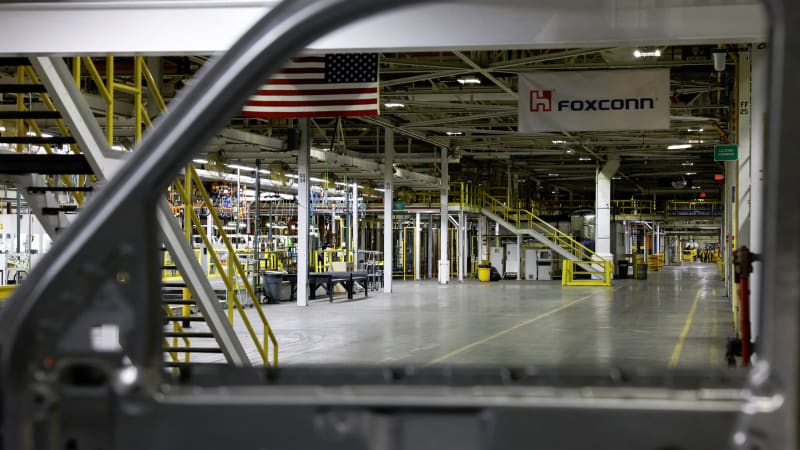Foxconn finds EVs are harder to build than iPhones

Over the past decade, Foxconn Technology Group has followed increasingly complex plans from Apple Inc. to turn silicon, glass, plastic, copper and other materials into hundreds of millions of iPhones. And Apple is just one of the Taiwanese company’s dozens of A-list customers; Google, Microsoft, Sony and many others have hired it to make phones, computers, tablets, game consoles, servers and more. So it’s not much of a stretch to think Foxconn might do the same for cars.
So far, though, cars are turning out to be a tougher slog than electronic gadgets.
Last year, Foxconn paid $230 million for a former General Motors Co. factory in Lordstown, Ohio, aiming to make it the center of a US auto-manufacturing push. As part of the deal, the previous owner of the 6.2 million-square-foot plant, four-year-old Lordstown Motors Corp., hired Foxconn to build its Endurance pickup truck, and the Taiwanese company took a stake in the startup.
Foxconn has made grand predictions for its auto business, saying it will generate $33 billion in annual revenue by 2025. And it’s announced partnerships in Taiwan, Thailand and Saudi Arabia. Although its electric vehicle components business is on track to grow fivefold to more than $3 billion this year, at this point the only vehicles Foxconn has made are a handful of prototypes, a few dozen electric buses and about 40 pickups for Lordstown.
Foxconn’s entry Into EVs
May 2022: Completes deal with Lordstown Motors to acquire Ohio factory for $230 million.
October 2022: Unveils two EVs to be built in Taiwan, Thailand and the US.
November 2022: Teams up with Saudi wealth fund to build EVs.
November 2022: Agrees to invest as much as $170 million in Lordstown and takes two board seats.
January 2023: Hires former Nissan exec Jun Seki as chief strategy officer for EVs.
In January, Lordstown asked Foxconn to suspend production because the cost of making the trucks exceeded the targeted sale price of $65,000. A few weeks later it became clear that the Endurance suffered from, well, a lack of endurance. At least one owner reported that the truck had lost power while driving in cold weather, prompting the company in February to issue a recall. Then on March 6, Lordstown said that if it can’t team up with an experienced automaker, it would be forced to discontinue the pickup, its only model.
The announcement raises questions about Foxconn’s nascent EV business. Lordstown was effectively saying Foxconn couldn’t keep its flagship vehicle in production despite its vast resources, its expertise in turning ideas into products and decades of wrangling global supply chains to get those products out the factory door on time and at cost. “Why does Lordstown need another strategic partner to bring the ailing project to fruition?” asks Danni Hewson, an analyst at brokerage AJ Bell. “Is it because Foxconn’s simply not ready to become an EV powerhouse without a bit of outside help?”
Foxconn says that it remains committed to its EV plans and that its experience in electronics sets the stage for success in cars. But while Lordstown has pledged to continue developing new vehicles with the Taiwanese company, the track records of other potential customers suggest Foxconn remains far from realizing its e-car dreams. “You need people skilled in volume production,” says Ron Harbour, an independent industry manufacturing consultant. “It can be done, but I haven’t seen that demonstrated by startup electric car companies. I’d call it a long shot.”
Closest to production is Monarch Tractor, which last August hired Foxconn to manufacture autonomous electric farm vehicles. Monarch makes them in limited numbers at a facility in Livermore, California, and the companies plan to shift production to Lordstown by the end of March.
Less certain is Fisker Inc. Foxconn is in talks with the Los Angeles company to build a sub-$30,000 EV known as the Pear. Fisker says it fully expects Foxconn to manufacture the car, but the two companies are still negotiating the cost, according to people familiar with the matter. And in September, Foxconn signed an initial agreement with IndiEV, another startup in California. At the time, Foxconn called the prospect of building the company’s prototypes a “success story.” But at the end of September, IndiEV had less than $220,000 in the bank. The company now says that it aims to go public in a reverse merger, but that if it can’t complete that process by July, it risks going out of business.
Those collaborations could still succeed, and Foxconn may find other companies that want it to build their vehicles. But a site in Mount Pleasant, Wisconsin, illustrates what may lie ahead. That’s where, in June 2018, Foxconn executives and then-President Donald Trump held a groundbreaking ceremony for what was supposed to become a $10 billion, 20 million-square-foot LCD-panel factory that Trump heralded as “the eighth wonder of the world.”
Over the next two years, Foxconn repeatedly scaled back its ambitions. After originally promising to create 13,000 jobs at the site, Foxconn renegotiated its contract with the state in 2021. The company today says it’s invested more than $1 billion and hired about 1,000 people. Those people are making electronics such as computer servers, and Foxconn plans to add components for battery packs at the Wisconsin site to deepen ties to both existing automakers and startups. Still, Foxconn’s record in Wisconsin is a red flag, says Michael Shields, a researcher at Policy Matters Ohio, a nonprofit that evaluates the economic impact of big industrial investments in the state. “I do think there is cause for concern,” he says, “about what is going to happen in Lordstown.”







